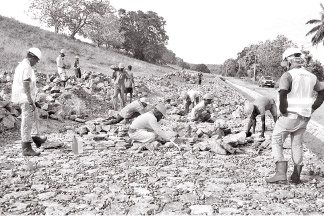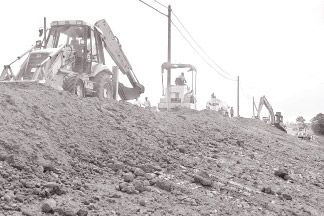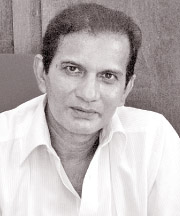|
Undertaking king sized job headed by DSWRPP:
Parakrama Samudra - back to its pristine glory
By Ananda KANNANGARA
Water has become the most needy component for the existence of human
beings, animals and the plantation. Even the great king Parakramabahu
who ruled the country for 33 years from 1153 AD- 1186 AD asked his
countrymen to use water sparingly.
Sri Lankan history reveals that King Parakramabahu had made an
immense contribution towards the agricultural industry in the country.
He constructed 165 dams, 2736 canals and 3910 small scale constructions.
|

Stone laying |
The Parakrama Samudra was his greatest ever contribution to the
people of Sri Lanka.
King Parakramabahu's famous quote on water conservation and
utilisation "Do not release even a drop of rain water to the sea without
using " is still living in the hearts of people. This is sound advice to
many present day people who have no respect or do not know the value of
this nature's gift.
The value of water was not only realised by our ancient kings such as
great Parakramabahu, Kings Dutugemunu, Dhatusena, Aggabodi, Pandukabaya,
Devanampiyatissa, Vasabha, Mahasena and Vijayabahu, but also the kings
and Governors who ruled the country during the colonial era.
The ancient kings constructed tanks and dams by using earth and rocks
to preserve water for over 100 years.
They used human energy to construct dams and the services of
elephants to press earth and to move huge rocks.
Their objective was to make the country self-sufficient in rice and
also created the island as the granary of the East. The country was then
called the 'Rice bowl of Asia'.
The ancient kings constructed massive tanks including the Parakrama
Samudra, Kanthale Wewa, Tissa Wewa, Thabbowa Wewa, Minneriya Wewa,
Girithale Wewa, Kawudulla Wewa and Hurulu Wewa.
Although these water tanks still provide adequate water to irrigate
thousands of agricultural lands in the dry zone and also drinking water
to millions of people, the dams, tank basins, sluice gates, anicuts,
irrigation canals and river basins of the tanks need renovations.
|

Work in progress |
After a careful survey, the Ministry of Irrigation and Water
Management with the assistance of the Irrigation Department started a
'Dam Safety and Water Resources Planning Project' (DSWRPP) in 2008 at
Kantale tank. President Mahinda Rajapaksa inaugurated the project.
The DSWRPP was set up with the objective of improving the development
and management of dams and water resources within the country. Although
there are 80 major tanks all over the country, the Government has
identified the dams of 32 tanks that need rehabilitation. These dams
have been identified as high risk to the public safety.
Out of this, nine tanks including Kantale and Parakrama Samudra need
immediate renovations. The other seven tanks that need dam renovations
are Dambulu Oya, Bowatanne, Kandalama, Inginimitiya, Siyambalangamu,
Tabbowa and Ridiyaghama tanks.
Meanwhile, the DSWRPP has also decided to provide basic safety
facilities to other 48 tanks.
Accordingly, the Government on the instructions of Irrigation and
Water Resources Management, Minister Nimal Siripala de Silva commenced
the dam renovation work of these nine tanks including the Parakrama
Samudra in Polonnaruwa and the Kantale tank in Kantale.
The DSWRPP is the official partner who undertook the responsibility
to complete the dam safety and water resources planning work of these
two projects.
The Sunday Observer last week had a rare opportunity to visit the
renovation sites of these two projects, the Parakrama Samudra and
Kantale tank with the assistance of DSWRPP, Communication Officer Ashoka
Herath.
According to Project Director, Senior Engineer D.C.S. Elakanda, the
renovations of these nine dams and its water resources planning work
will cost the Government Rs. 7500 million.
Irrigation Engineer I. Kanankage said the renovation work of the
Kantale dam safety project will be completed by March next year.
The history reveals that Kantale tank was built by king Aggabodi
during 608 AD -618 AD and the tank was later rehabilitated by King
Parakramabahu. Later the Dutch national who controlled the coastal areas
of Trincomalee also carried out some rehabilitation work of this
reservoir.
The then British Governor Sir William Gregory also commissioned some
renovations during 1833.
During the latter part the then Prime Ministers D.S. Senanayaka and
Dudley Senanayaka also took prompt action to finish some renovations on
the requests of village farmer community.
According to Engineering Assistant, Amila de Silva, financial
assistance is provided by the Government of Sri Lanka and the World
Bank. The total cost of the project is Rs. 133 million.
|

Engineer I. Kanankage |

Engineer D.C.S. Elakanda |

Asst. Engineer Amila de Silva |
He said due to the current drought the normal water level of 38 feet
has now dropped to 24 feet. The capacity of water level is 114,000 acre
feet.
"We provide 60 per cent of water everyday to cultivate over 22,000
paddy lands and other 40 percent for drinking purposes and for the
benefit of people engaged in inland fishing industry,".
We have two sluice gates to provide water for agricultural purposes.
One gate is open to release water on all seven days of the week, while
the other gates are open only for five days.
When the water comes to the spill level during December and January
monsoon season, all sluice gates are opened during the entire week.
The dam renovation program of Sri Lanka's largest tank, the Parakrama
Samudra was also commenced by the DSWRPP in September last year.
According to Project Engineering Assistant, L.A. Harischandra the
total cost of the project is Rs. 167 million and the work will be
completed by August, next year.
The history reveals that Parakrama Samudra is a combination of three
large tanks, the Thopawewa, Dumbutulu Wewa and Erabadu Wewa.
After the period of King Parakramabahu, the tank dam was
rehabilitated by former Prime Minister D.S. Senanayaka in 1948.
Thereafter, some dam renovations were carried out by Engineer
A.D.S. Gunawardana in 1979.The length of the dam is 12.300 km and it
covers a wide water spread area of 6272 acres. The full capacity of
water of Parakrama Samudra is 109,000 acre feet.
The Parakrama Samudra provides 99 percent of its water to cultivate
over 30,000 paddy lands and the remaining one percent of water for
drinking purposes and to develop the fishing industry. |

